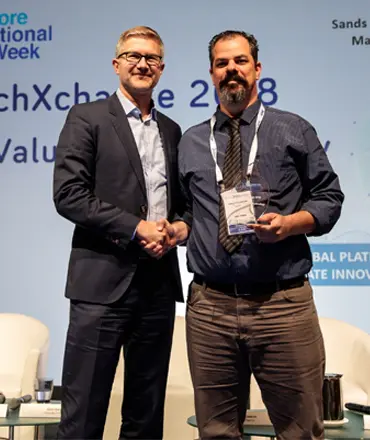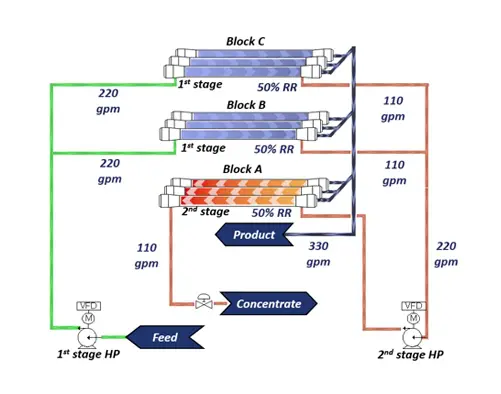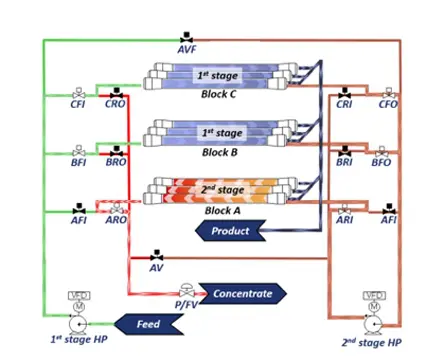ROTEC Technology
We’re tackling some of the world’s most pressing water challenges through robust, long-term, in-house R&D. All our flagship proprietary water and wastewater treatment technologies are game changers. They outperform competing technologies and transform drinking water and industrial wastewater into safe and valuable assets. In line with the WFI Group vision, and with genuine drive and care for people and the environment, our technologies power breakthrough solutions that enhance public health, sustainability and growth.
FLOW REVERSAL TECHNOLOGY
THE GOLD STANDARD IN HIGH-RECOVERY DESALINATION
Flow Reversal is a ground-breaking desalination technology that can be implemented in new and existing Reverse Osmosis (RO) desalination plants. Enabling the latest and most cost-effective solution on the market, it allows a significant increase in product water capacity while maintaining the amount of feed water. Alternatively, it reduces the amount of feed water while maintaining the amount of product water. In all cases, Flow Reversal reduces the capacity of the brine reject. ROTEC’s solutions are available in a variety of applications for a variety of market segments.
The principle of Flow Reversal technology is based on periodically changing the flow direction of the saline stream, thus preventing scales from forming on membranes. Additionally, ROTEC developed a patented approach involving block repositioning, in which individual blocks can be repositioned between the stages, so that the blocks of pressure vessels can be switched. Beyond improving water treatment capacity, this approach also allows less-frequent cleaning in place (CIP).
With its Flow Reversal technology, ROTEC won the “Most Valuable Technology” award at SIWW Expo 2018 in Singapore.

THE RECOVERY RATE CHALLENGE
Membrane-based technologies, such as Reverse Osmosis (RO) and Nano Filtration (NF), are the most widespread methods used today for producing fresh water from saline water.
However, standard RO systems typically achieve a recovery rate of just 45%-50% in the case of Sea Water RO desalination (SWRO) and 70%-80% for Brackish Water RO desalination (BWRO). This leaves 50-55% and 20-30% respectively of the feed water as concentrated saline reject (brine), which must be disposed of or treated according to local regulations. Nowadays, as water consumption increases and water resources dwindle, these processes are neither economically nor environmentally efficient.
Increasing the recovery rate of a RO system is fairly simple, requiring no structural changes to the system aside from increasing system pressure and minor operational adaptations. However, there are significant obstacles to increasing the recovery beyond the typical rates. Mineral scaling, the process in which mineral deposit forms on the membrane surface of a RO element, causing membrane plugging and loss of water permeability, is the main obstacle in BWRO desalination. It sometimes occurs even with standard recovery operations. Increasing recovery rates leads
to numerous operational issues, such as more frequent membrane cleaning, and consequently, a shorter membrane life span. Therefore, the addition of expensive anti-scalant chemicals is required to inhibit and moderate the effects of this phenomenon. In SWRO systems, osmotic pressure issues limit recovery rates more than mineral scaling as the feed water contains relatively low concentrations of sparingly soluble salts, leading to less scaling. SWRO suffer mostly from another type of fouling (mainly biofouling).
A NEW FLOW FOR RO
Our proprietary Flow Reversal technology solves the challenges, enabling dramatically more productive and cost-effective higher recovery than any other RO approach. This decreases the amount of feed water that requires pumping and significantly diminishes the brine, reducing energy costs and eco-footprint.
ROTEC’s proprietary, patented Flow Reversal (FR) technology prevents scaling even at high recoveries by implanting design changes in standard RO desalination systems, whether new or existing installations.
Flow Reversal is a smart process for operating desalination systems, in which the flow direction of the saline stream in RO pressure vessel arrays is periodically switched (see diagram). By periodically switching the flow direction, scale does not have time to form on membrane surfaces before being swept away by under-saturated feed solution conditions. The frequency of switching is dictated by the time it takes for a supersaturated solution in the concentrate to grow a population of scale particles that can allow continued scale growth. By using the effectively under-saturated feed to sweep away the nascent scale particles in the concentrate before they exceed a critical size, extensive precipitation is prevented. This approach enables much higher recovery ro rates than can be achieved with anti-scalants alone.

Industrial Application of Flow Reversal Technology
ROTEC made further improvements to Flow Reversal technology to adapt it to industrial desalination settings, which are dominated by multi-stage RO systems that use a tapered flow arrangement of pressure vessels (PVs) to maintain correct hydraulic flows in the PVs of sequential stages.
The tapered flow arrangement of PVs involves placing fewer pressure vessels in parallel in downstream stages than in upstream stages. With the lower amount of feed flowing in the downstream stage divided between fewer PVs, a minimum crossflow rate is preserved in the downstream pressure vessels. This helps prevent fouling by colloids, organics and biomaterials, while reducing the concentration of salts at the membrane surface. Simultaneously, it prevents too large a stream from flowing into the individual pressure vessels of the first stage.
A simplistic flow reversal method, in which the feed is fed to the original last stage and concentrate is removed from the entrance of the original first stage, would cause the flow to be too high into the last-stage pressure vessels and too low out of the first-stage pressure vessels.
To prevent this, ROTEC developed a patented approach in which individual blocks can be repositioned between the stages, so that the block of pressure vessels from the last stage is switched with a block of equal number of pressure vessels from the first stage by using a sophisticated array of valves and valve sequencing.

2 stages conventional RO | 3 blocks |
440 gpm | RR 75%

2 stages ROTEC FR-RO | Additional valves &
pipes | Block A is 2nd stage | FR adaptation to
tapered flow array

Flow is now reversed | Block B is 2nd stage | FR
adaptation to tapered flow array

Flow is now reversed | Block C is 2nd stage | FR
adaptation to tapered flow array


